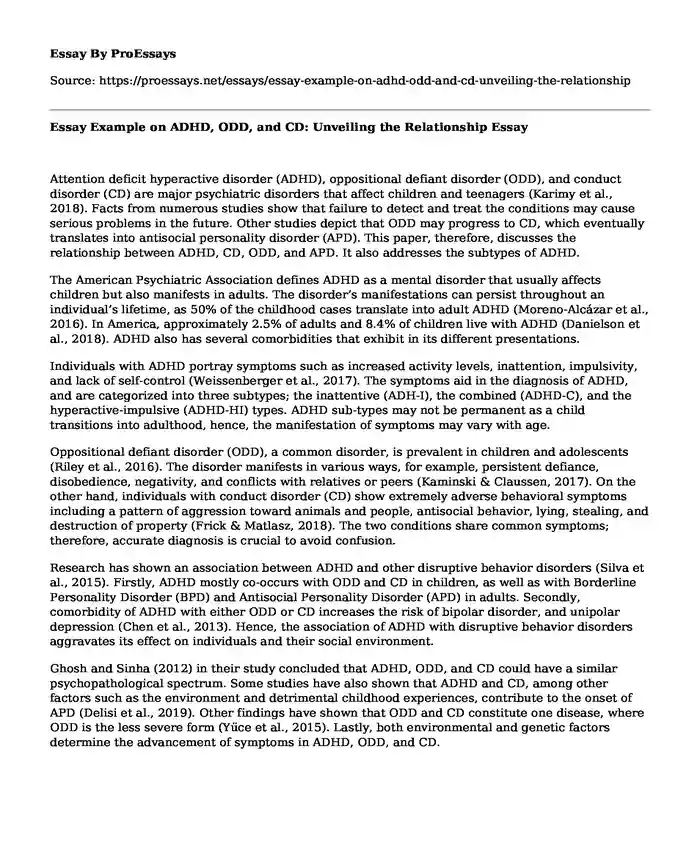Attention deficit hyperactive disorder (ADHD), oppositional defiant disorder (ODD), and conduct disorder (CD) are major psychiatric disorders that affect children and teenagers (Karimy et al., 2018). Facts from numerous studies show that failure to detect and treat the conditions may cause serious problems in the future. Other studies depict that ODD may progress to CD, which eventually translates into antisocial personality disorder (APD). This paper, therefore, discusses the relationship between ADHD, CD, ODD, and APD. It also addresses the subtypes of ADHD.
The American Psychiatric Association defines ADHD as a mental disorder that usually affects children but also manifests in adults. The disorder’s manifestations can persist throughout an individual’s lifetime, as 50% of the childhood cases translate into adult ADHD (Moreno-Alcázar et al., 2016). In America, approximately 2.5% of adults and 8.4% of children live with ADHD (Danielson et al., 2018). ADHD also has several comorbidities that exhibit in its different presentations.
Individuals with ADHD portray symptoms such as increased activity levels, inattention, impulsivity, and lack of self-control (Weissenberger et al., 2017). The symptoms aid in the diagnosis of ADHD, and are categorized into three subtypes; the inattentive (ADH-I), the combined (ADHD-C), and the hyperactive-impulsive (ADHD-HI) types. ADHD sub-types may not be permanent as a child transitions into adulthood, hence, the manifestation of symptoms may vary with age.
Oppositional defiant disorder (ODD), a common disorder, is prevalent in children and adolescents (Riley et al., 2016). The disorder manifests in various ways, for example, persistent defiance, disobedience, negativity, and conflicts with relatives or peers (Kaminski & Claussen, 2017). On the other hand, individuals with conduct disorder (CD) show extremely adverse behavioral symptoms including a pattern of aggression toward animals and people, antisocial behavior, lying, stealing, and destruction of property (Frick & Matlasz, 2018). The two conditions share common symptoms; therefore, accurate diagnosis is crucial to avoid confusion.
Research has shown an association between ADHD and other disruptive behavior disorders (Silva et al., 2015). Firstly, ADHD mostly co-occurs with ODD and CD in children, as well as with Borderline Personality Disorder (BPD) and Antisocial Personality Disorder (APD) in adults. Secondly, comorbidity of ADHD with either ODD or CD increases the risk of bipolar disorder, and unipolar depression (Chen et al., 2013). Hence, the association of ADHD with disruptive behavior disorders aggravates its effect on individuals and their social environment.
Ghosh and Sinha (2012) in their study concluded that ADHD, ODD, and CD could have a similar psychopathological spectrum. Some studies have also shown that ADHD and CD, among other factors such as the environment and detrimental childhood experiences, contribute to the onset of APD (Delisi et al., 2019). Other findings have shown that ODD and CD constitute one disease, where ODD is the less severe form (Yuce et al., 2015). Lastly, both environmental and genetic factors determine the advancement of symptoms in ADHD, ODD, and CD.
Conclusion
In conclusion, Attention Deficit Hyperactive Disorder, Oppositional Defiant Disorder, and Conduct Disorders are mental conditions that occur in children and adolescents. On the other hand, Antisocial Personality Disorder is seen mainly in adults. ADHD is the most common mental disorder that exhibits itself in three key subtypes, namely, ADHD-I, ADHD-HI, and ADHD-C. ODD and CD are disruptive behavior disorders that can progress into APD with delayed detection and treatment. Finally, there is an association between these disorders, as depicted by the similarity in several symptoms.
References
American Psychiatric Association. (n.d). What is ADHD. https://www.psychiatry.org/patients-families/adhd/what-is-adhd
Chen, M. H., Su, T. P., Chen, Y. S., Hsu, J. W., Huang, K. L., Chang, W. H., ... & Bai, Y. M. (2013). Higher risk of developing mood disorders among adolescents with comorbidity of attention deficit hyperactivity disorder and disruptive behavior disorder: a nationwide prospective study. Journal of psychiatric research, 47(8), 1019-1023.
Danielson, M. L., Bitsko, R. H., Ghandour, R. M., Holbrook, J. R., Kogan, M. D., & Blumberg, S. J. (2018). Prevalence of parent-reported ADHD diagnosis and associated treatment among US children and adolescents, 2016. Journal of Clinical Child & Adolescent Psychology, 47(2), 199-212.
DeLisi, M., Drury, A. J., & Elbert, M. J. (2019). The etiology of antisocial personality disorder: The differential roles of adverse childhood experiences and childhood psychopathology. Comprehensive Psychiatry, 92, 1-6.
Frick, P. J., & Matlasz, T. M. (2018). Disruptive, impulse-control, and conduct disorders. In Developmental Pathways to Disruptive, Impulse-Control, and Conduct Disorders (pp. 3-20). Academic Press.
Kaminski, J. W., & Claussen, A. H. (2017). Evidence base update for psychosocial treatments for disruptive behaviors in children. Journal of Clinical Child & Adolescent Psychology, 46(4), 477-499.
Karimy, M., Fakhri, A., Vali, E., Vali, F., Veiga, F. H., Stein, L. A., & Araban, M. (2018). Disruptive behavior scale for adolescents (DISBA): development and psychometric properties. Child and adolescent psychiatry and mental health, 12(1), 17.
Riley, M., Ahmed, S., & Locke, A. (2016). Common questions about oppositional defiant disorder. American Family Physician, 93(7), 586-591.
Weissenberger, S., Ptacek, R., Klicperova-Baker, M., Erman, A., Schonova, K., Raboch, J., & Goetz, M. (2017). ADHD, lifestyles, and comorbidities: A call for an holistic perspective–from medical to societal intervening factors. Frontiers in psychology, 8, 454.
Yuce, M., Uçar, F., & Say, G. N. (2015). Comorbid Conditions in Child and Adolescent Patients Diagnosed with Attention-Deficit/Hyperactivity Disorder. In ADHD-New Directions in Diagnosis and Treatment. IntechOpen.
Cite this page
Essay Example on ADHD, ODD, and CD: Unveiling the Relationship. (2023, Oct 21). Retrieved from https://proessays.net/essays/essay-example-on-adhd-odd-and-cd-unveiling-the-relationship
If you are the original author of this essay and no longer wish to have it published on the ProEssays website, please click below to request its removal:
- Essay on Social Class and Parenting Practices
- Research Paper on Marriage, Kinship, and Family
- Essay Sample on Leadership Experience Program
- Literary Analysis Essay on Shakespeare's Hamlet
- Theory X & Y: Human Work Inspiration & Management - Essay Sample
- Jenny's PTSD, Baby's Cleft Lip: Impact on Mental Health of New Mother - Essay Sample
- Paper Example on Doctors & Patients: Meeting Challenges in Treatment through Technology







